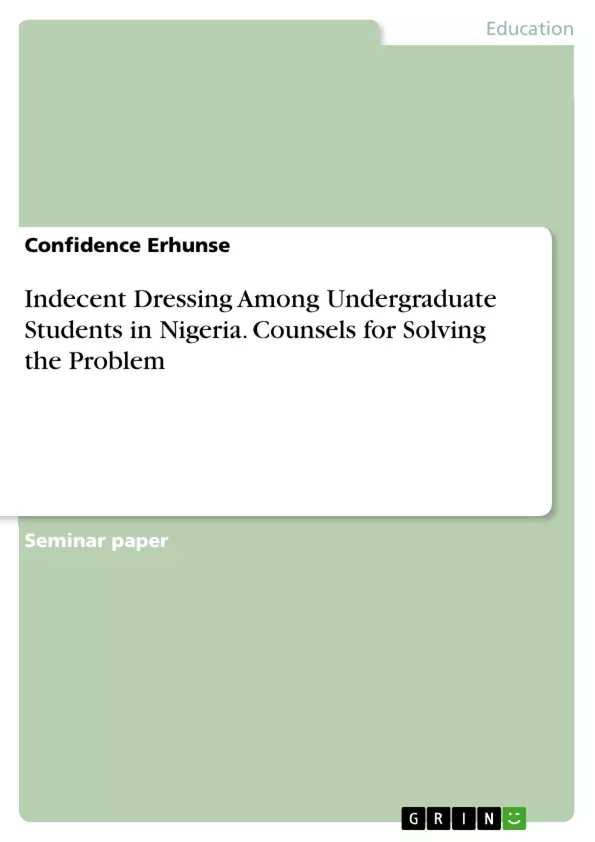This paper examines the issue of indecent dressing among undergraduate students in Nigerian tertiary institutions. Indecent dressing is one of the major problems that is eating up our youths, especially female students. The paper looks at meaning and types of indecent dressing, reasons why some student dress indecently and its effects on undergraduates in Nigerian tertiary institutions.
Dressing originated from the time Adam and Eve sewed fig leaves and made themselves aprons to cover their nakedness after eating the forbidden fruit. This shows that human beings are social animals blessed with degree of intelligence. Our mental ability enables us to cover nakedness. Therefore, dressing is an act of putting on clothes. Importance of wearing clothe on the body is in order to protect, beautify or adorn it. Clothes are one of the basic necessities of man. In its widest sense, it includes a great range of material that man wears or applies to the body. Clothing includes dresses, shoes, jewellery, hairdo and make- up. Clothing is also used to show people’s status and the roles they play in society. The clothes someone decides to wear influences the impression people have about such an individual. It also tells about the family such a person comes from. It can also affect the person’s comfort and self-confidence. The dressing pattern of an individual is a kind of “sign language” that communicates a complete set of information and is usually the basis on which immediate impressions are formed.
A dress is therefore said to be indecent when it has provocative or stimulating influence on almost all those that happen to view it on the user. Although, there are no universally acceptable ways of dressing, dresses are meant to serve some definable purposes, notwithstanding one’s country or region. They are part of people’s culture and they define their tribal or ethnic identity. Apart from dresses being a means for cultural identity, they are for ornamental or aesthetic purposes, for protection of the body against harsh weather conditions as well as for covering the intimate part of the body. These purposes are important especially as they form major aspects of a person’s personality. Indecent appearance has come to characterize the dress pattern of many students on the campuses of higher learning in Nigeria.
Table of Contents
- INTRODUCTION
- CONCEPT OF INDECENT DRESSING
- Meaning of Indecent Dressing.
- Types of Indecent Dressing.......
- REASONS WHY SOME UNDERGRADUATES STUDENTS DRESS INDECENTLY IN NIGERIA TERTIARY INSTITUTIONS
- EFFECTS OF INDECENT DRESSING AMONG UNDERGRADUATE STUDENTS IN NIGERIA TERTIARY INSTITUTIONS
- Theoretical Framework.......
- CONNSLLING ROLES FOR CURBING INDECENT DRESSING AMONG UNDERGUATES IN NIGERIAN TERTIARY INSTITUTION
- Conclusion
- Recommendations.
Objectives and Key Themes
This paper examines the issue of indecent dressing among undergraduate students in Nigerian tertiary institutions. The main goal is to understand the reasons behind this trend, analyze its effects on students, and discuss counseling strategies for addressing it.
- Definition and types of indecent dressing
- Factors contributing to indecent dressing among students
- Negative consequences of indecent dressing on students
- Counseling roles in curbing indecent dressing
- Recommendations for addressing the problem
Chapter Summaries
- Introduction: This section introduces the topic of indecent dressing in Nigerian tertiary institutions and highlights its prevalence. It emphasizes the importance of dressing for protection, beautification, and cultural expression.
- Concept of Indecent Dressing: This chapter defines indecent dressing as provocative or stimulating, emphasizing that while there are no universal standards, dresses should serve specific purposes. The chapter explores the various types of indecent dressing observed among students.
- Reasons Why Some Undergraduates Students Dress Indecently in Nigeria Tertiary Institutions: This section examines the factors that contribute to indecent dressing among students. It delves into the influence of peer pressure, modernization, and the desire for attention.
- Effects of Indecent Dressing Among Undergraduate Students in Nigeria Tertiary Institutions: This chapter explores the negative consequences of indecent dressing on students. It discusses potential risks such as vulnerability to harassment, social stigma, and negative self-image.
- Theoretical Framework: This section examines the theoretical framework underpinning the research. It explores relevant theories related to social influence, cultural identity, and the impact of dressing on social perception.
- Counseling Roles for Curbing Indecent Dressing Among Undergraduates in Nigerian Tertiary Institutions: This chapter outlines the role of counseling in addressing indecent dressing. It discusses strategies such as individual and group counseling, education on appropriate dressing, and fostering self-esteem.
Keywords
The core concepts and themes explored in this paper revolve around indecent dressing, its contributing factors, effects on students, and the role of counseling in addressing this issue. Key terms include indecent dressing, peer group influence, modernization, and counseling roles.
- Quote paper
- Confidence Erhunse (Author), 2019, Indecent Dressing Among Undergraduate Students in Nigeria. Counsels for Solving the Problem, Munich, GRIN Verlag, https://www.grin.com/document/507384



